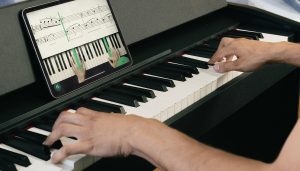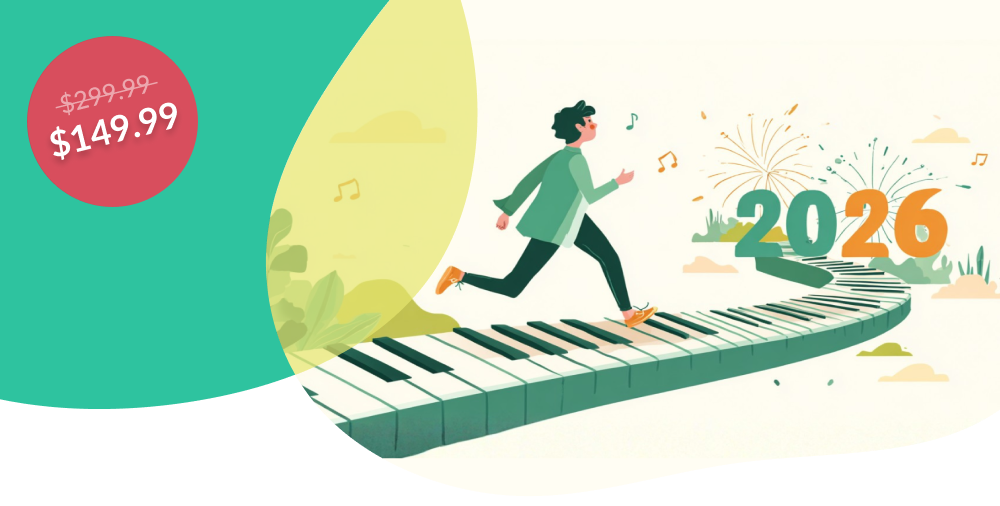Playing the piano is an incredibly fun experience, with a fair amount of challenges along the way. One of the most important steps any pianist must take if they wish to improve is learning how to play independently with both hands.
Piano hand independence is the ability to play separate rhythms, melodies, and/or chords or different volumes with each hand at the same time. Developing this skill will allow you to play more complex and emotionally expressive music.
Developing hand independence can be daunting, but with consistent practice and the right approach, it is achievable. In this guide, we will explore what piano hand independence is, why it is essential, and how you can develop it through various exercises and techniques.
- Fall in love with the music - Learn your favorite songs, at a level suitable for you.
- Enjoy interactive piano lessons - Explore courses covering music theory, technique chords & more.
- Get real-time feedback - Skoove's feedback tells you what went well and what needs practice.

Understanding piano hand independence
Hand independence is the ability to perform different tasks with each hand simultaneously. This skill is vital in piano as it allows one hand to play a melody while the other plays chords or different rhythmic patterns. Developing this skill can be daunting, but with consistent practice and the right approach, it is achievable.
Challenges of developing hand independence
Learning how to develop hand independence on piano is challenging for several reasons. Playing different parts with each hand requires significant mental coordination. Your brain has to process and execute multiple tasks simultaneously, which can be overwhelming, especially for beginners.
Furthermore, each hand must move independently, which can be difficult if you are not accustomed to using them separately. This requires developing fine motor skills and muscle memory. Both hands must be synchronized to ensure the music sounds coherent, which can be challenging to master.
As you progress to more advanced pieces, the complexity of the music increases, demanding higher levels of hand independence. This can be intimidating and requires persistent effort and practice.
Benefits of achieving hand independence in piano playing
Despite the challenges, achieving hand independence offers numerous benefits and will enhance your piano playing in myriad ways. Hand independence allows for more dynamic and expressive playing. You can bring out the melody while maintaining a steady accompaniment, adding depth and emotion to your performance.
Many piano pieces, especially classical and contemporary works, require hand independence. Developing this skill broadens your repertoire, enabling you to play a wider variety of music. As you master hand independence, you will feel more confident in your abilities as a pianist. This confidence will motivate you to tackle more challenging pieces and continue improving.
Developing piano hand independence: essential exercises
To develop hand independence, it’s crucial to practice specific piano hand independence exercises that challenge your hands to perform different tasks. Let’s explore some strategies you can incorporate immediately into your piano playing.
Hands separate practice
First, choose a simple melody and practice it slowly with your right hand. Pay attention to finger placement, dynamics, and articulation. Once you feel comfortable, gradually increase the tempo.
Then, practice the left-hand accompaniment separately. Focus on maintaining a steady rhythm and playing each note clearly. Start slowly and increase the tempo as you become more comfortable.
Finally, once you have mastered each hand separately, try playing both hands together. Start slowly and focus on synchronization. Gradually increase the tempo as you become more confident.
Simple hand independence exercises
Apart from simply breaking down the repertoire you already practice into separate hands, you can employ a number of technique practices to increase your hand independence. Let’s check out a few piano hand independence exercises you can test out in your next practice session.
Practice playing different rhythmic patterns with each hand. For example, play quarter notes with your right hand and half notes with your left hand. This helps improve your ability to perform different rhythms simultaneously.
Another idea is to practice playing scales with one hand while playing arpeggios with the other. This exercise helps improve coordination and finger strength. Start with simple scales and arpeggios and gradually progress to more complex patterns.
You can also try playing scales or arpeggios in contrary motion, where each hand moves in opposite directions. This exercise challenges your brain and enhances coordination. Start with simple scales and gradually progress to more complex patterns.
Bach’s inventions
J.S. Bach’s Inventions are excellent pieces for developing hand independence and are commonly used by pianists of all ability levels to increase their dexterity. These compositions require each hand to play a distinct melodic line, making them ideal for practicing coordination and independence. You can use the tips about practicing each hand separately to master these pieces.
Hanon exercises
The Hanon exercises are a collection of piano exercises for hand independence. These exercises are essential for developing hand independence and overall piano technique. Skoove features a number of video lessons incorporating Hanon exercises.
Practicing hand independence with Skoove
Skoove is an innovative online piano learning platform that offers interactive lessons and real-time feedback. It is an excellent tool for developing piano hand independence, thanks to its structured lessons and personalized approach. Skoove can help you develop your hand independence and piano skills in many ways.
First, Skoove offers a variety of lessons that focus on hand independence, from beginner to advanced levels. These lessons guide you through exercises and pieces that challenge your hands to work independently. Here are some features of Skoove’s interactive lessons:
- Step-by-step guidance: Skoove’s lessons are designed to guide you step-by-step through each exercise. This ensures that you are practicing correctly and effectively.
- Real-time feedback: Skoove provides real-time feedback on your playing, helping you identify areas that need improvement and track your progress.
- Engaging content: Skoove’s lessons are engaging and interactive, making practice enjoyable and motivating.
Second, one of the standout features of Skoove is its real-time feedback. As you play, Skoove listens and provides immediate feedback on your performance as you learn how to play piano. This helps you identify mistakes and areas for improvement, ensuring that you are practicing correctly. Here are some benefits of real-time feedback:
- Instant corrections: Real-time feedback allows you to make instant corrections, ensuring that you are practicing correctly.
- Progress tracking: Skoove tracks your progress and provides insights into your strengths and areas for improvement.
- Motivation: Seeing your progress in real-time can be highly motivating and encourages consistent practice.
Third, the platform adapts to your skill level and learning pace, ensuring you are always challenged but not overwhelmed. Skoove’s personalized learning approach includes the following features:
- Customized lessons: Skoove tailors lessons to your skill level and learning goals, ensuring that you are always challenged but not overwhelmed.
- Adaptive learning: Skoove adapts to your progress, providing more challenging exercises as you improve.
- Supportive environment: Skoove creates a supportive learning environment, encouraging you to practice consistently and achieve your goals.
Finally, with Skoove, you can practice anytime, anywhere, making it easier to incorporate hand independence exercises into your daily routine. Here are some benefits of Skoove’s convenience:
- Flexible scheduling: Skoove allows you to practice at your own pace and on your own schedule.
- Accessible anywhere: Skoove is accessible on multiple devices, allowing you to practice anytime, anywhere.
- Consistent practice: The convenience of Skoove makes it easier to incorporate regular practice into your daily routine, ensuring consistent progress.
Gain your independence today!
Developing piano hand independence is not an easy journey, but it is well worth the time! By developing your hand independence, you will be able to play more complex music, access a greater degree or musical expression, and be able to infuse more nuance, emotion, and subtlety into your piano playing! Not to mention, you will become genuinely better at the instrument!
By practicing specific exercises, using tools like Skoove, and following our tips for success, you can achieve this essential skill and take your piano playing to the next level. With consistent practice and dedication, you will see significant improvements in your coordination, dexterity, and overall proficiency as a pianist!
Author of this blog post:
Susana Pérez Posada

With over seven years of piano education and a deep passion for music therapy, Susana brings a unique blend of expertise to Skoove. A graduate in Music Therapy from SRH Hochschule Heidelberg and an experienced classical pianist from Universidad EAFIT, she infuses her teaching with a holistic approach that transcends traditional piano lessons. Susana’s writings for Skoove combine her rich musical knowledge with engaging storytelling, enriching the learning experience for pianists of all levels. Away from the piano, she loves exploring new places and immersing herself in a good book, believing these diverse experiences enhance her creative teaching style.
Published by Lydia Hovan from the Skoove team















